10 Eye-Catching Freshwater Fish for Aquariums


Written and verified by the biologist Cesar Paul Gonzalez Gonzalez
Aquaristics is a hobby that has gained more and more popularity. While it’s true that marine species tend to be more colorful, freshwater species are a bit easier to care for and maintain. This is one of the reasons why many enthusiasts opt to have eye-catching freshwater fish for aquariums.
If you are ready to take on the challenge and commit to their well-being, you’ll surely need ideas on some colorful species you could think about acquiring. Continue reading and discover 10 beautiful and ideal fish for your freshwater aquarium.
Striking freshwater fish for aquariums
The color of fish can be considered a simple aesthetic feature. However, for aquatic species this aspect is essential for their adaptive mechanisms. According to an article published in the journal Current Opinion in Genetics & Development
In other words, the colors of fish are a decisive factor in the evolution of species. For this reason, many of them prioritize the development of complex, colorful, and eye-catching coloration patterns.
As if that weren’t enough, selective breeding of these animals has also produced even more attractive variants. This means that brightly colored species are encouraged for decorative use in the aquarium.
Many people are attracted by the appearance of these animals, but they don’t always know their names. Therefore, we would like to share with you a list of 10 striking freshwater fish species for aquariums.
1. Betta fish (Betta splendens)

Originally from Asia, the betta fish, also known as the Siamese fighting fish, is one of the best known and most widely used species in aquarium keeping. Apart from the fact that they exhibit flashy and eye-catching colorations, their maintenance in the aquarium isn’t very complex and doesn’t require much investment.
A publication of the Electronic Veterinary Journal indicates that males tend to have the strongest coloration and the longest fins. In view of this, if you are looking for a flashy freshwater fish, it’s preferable to look for males.
That said, remember that this species tends to be aggressive towards conspecifics and other species (especially the male), so you will need to be careful when choosing mates.
2. Neon tetra fish (Paracheirodon innesi)
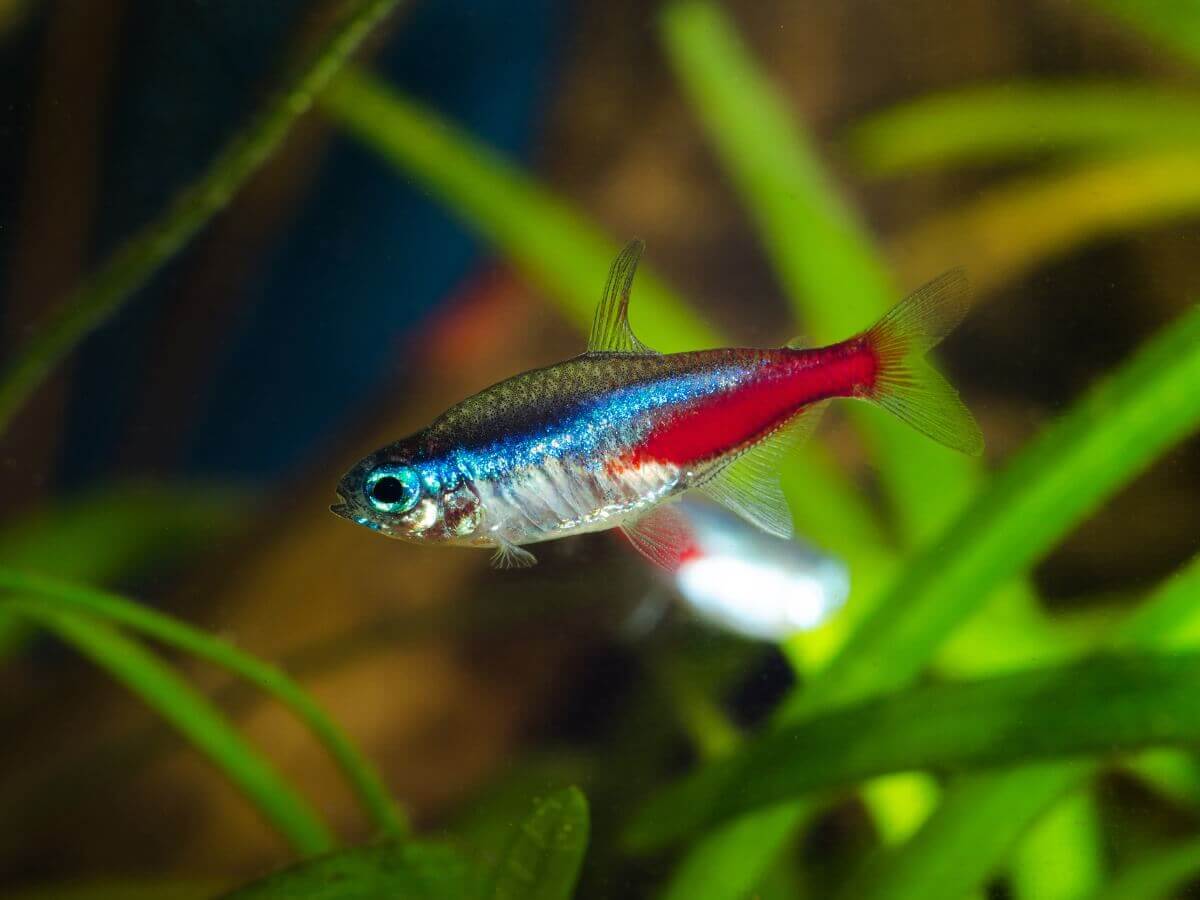
The neon tetra fish hails from South America and is one of the most prized freshwater fish for ornamental breeding. This is not only due to its iridescent colorations, but also to its gentle and social behavior. In addition, it is undemanding in terms of water quality and maintenance. These aspects make it an excellent addition to aquariums.
3. Goldfish (Carassius auratus)
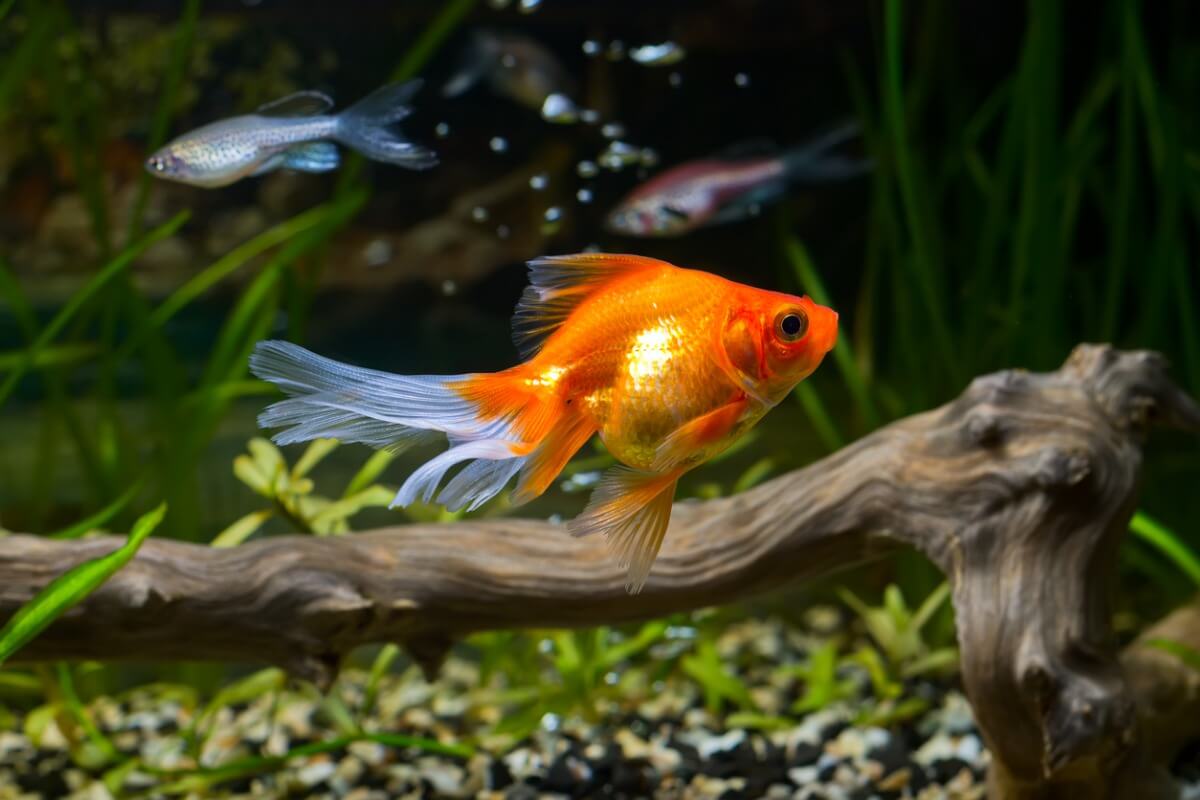
The goldfish is perhaps the most popular freshwater fish species in the world, as its domestication is so old that it has been in the ornamental market for several hundred years. In general, it’s a small fish that boasts bright yellow and orange colors that are very attractive to the eye.
In addition, the lineage has different varieties that differ in their morphological characteristics. They range from those with larger fins, such as the kite variety, to specimens that have sacs that inflate like bubbles (bubble variety).
4. Koi fish (Cyprinus carpio koi)
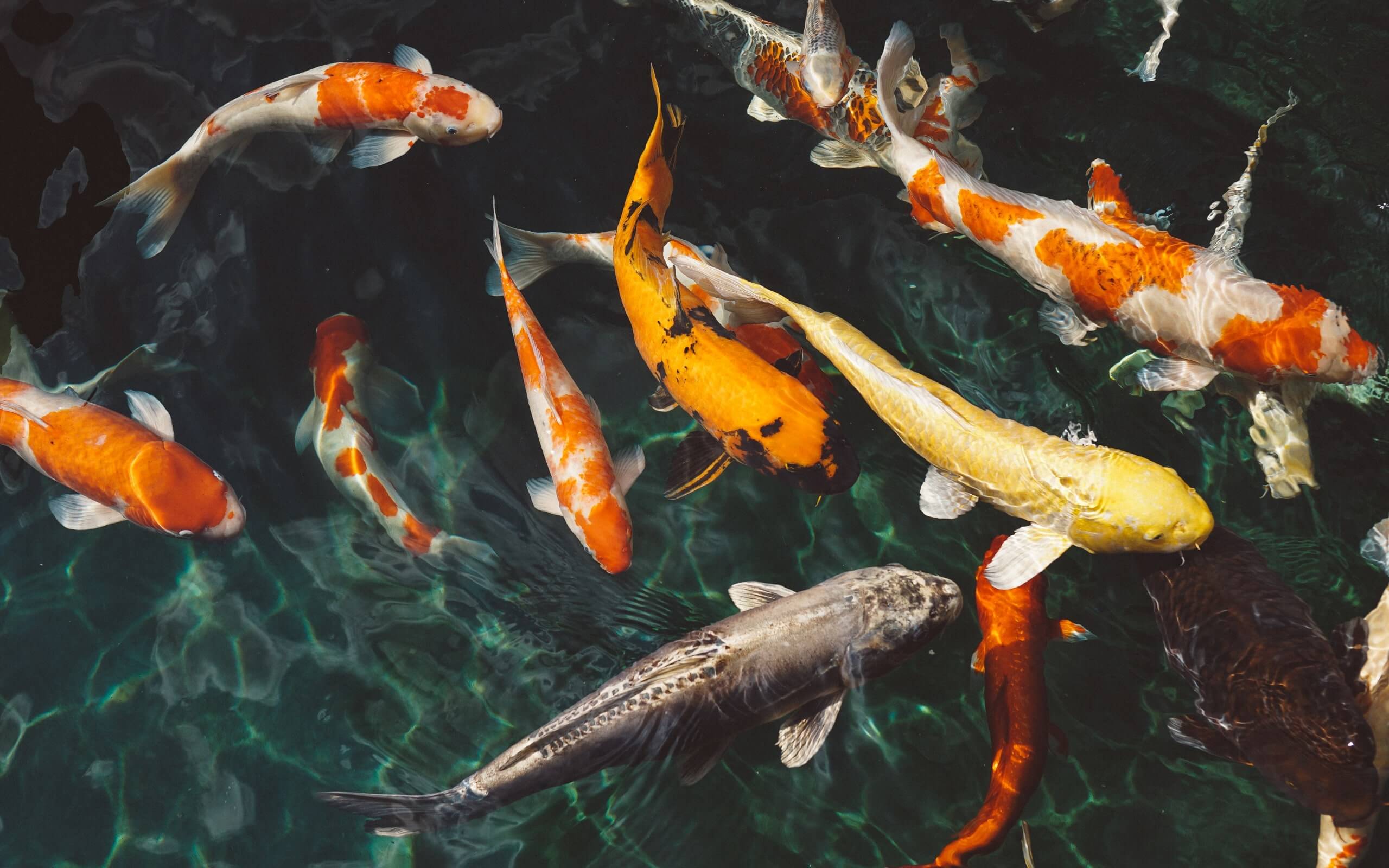
Koi fish are native to the Asian continent and belong to the same species as common carp. However, this subspecies arose from selective breeding, so priority was given to maintaining intense and bright colorations in its lineage.
As a result, today’s specimens have complex color patterns that include yellow, white, orange, blue and black tones.
Like the common carp, this fish is quite resistant to adverse conditions. However, the healthiest specimens are the ones that tend to show the most showy and attractive colorations. This is one more reason to take care of your pet and not neglect its needs.
5. Angelfish (Pterophyllum scalare)
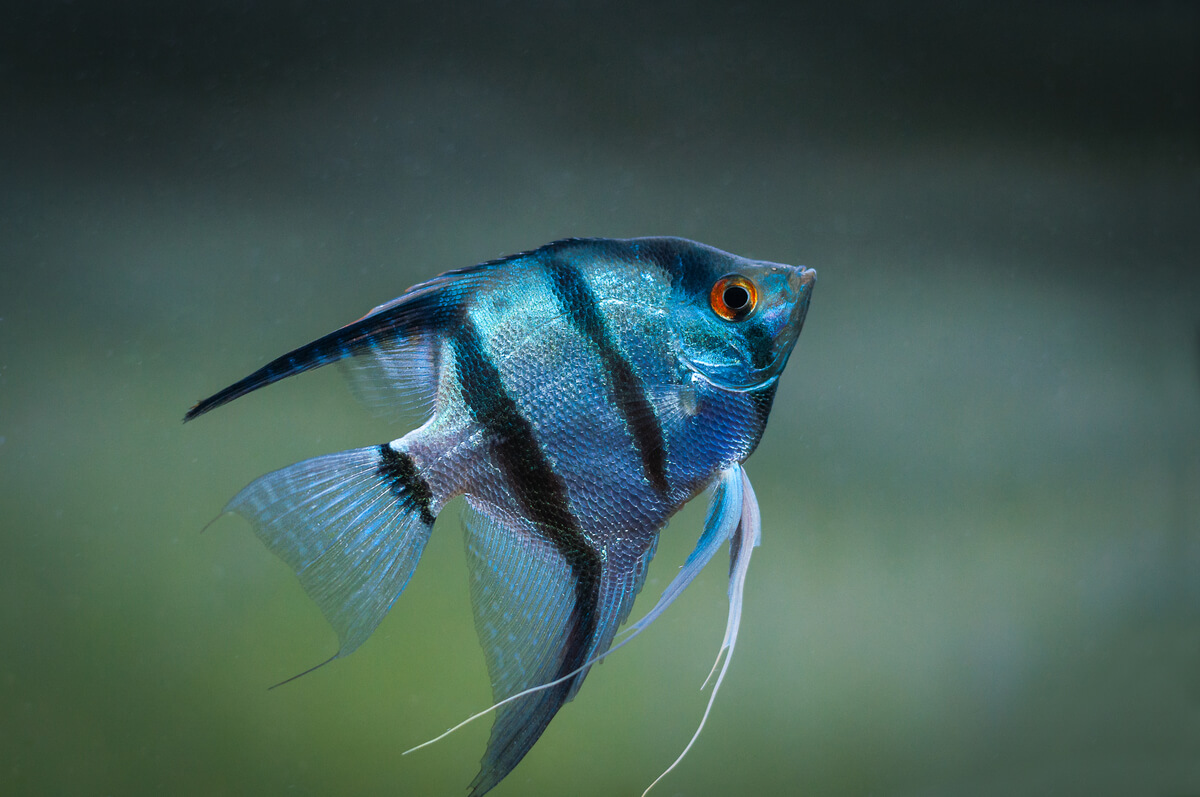
The angelfish is a species with a flattened, rhomboidal appearance that is characterized by highly elongated fins. It exhibits bright colorations with a wide range of shades, which are considered varieties. In addition, it has a medium size that shows off its coloration patterns well, although this also prevents having several specimens in a small aquarium.
Usually, the angelfish resists adverse conditions occasionally and doesn’t require much attention. Even so, it’s advisable to have a good filtration system and a wooden decoration to resemble their natural environment.
6. Endlers fish (Poecilia wingei)
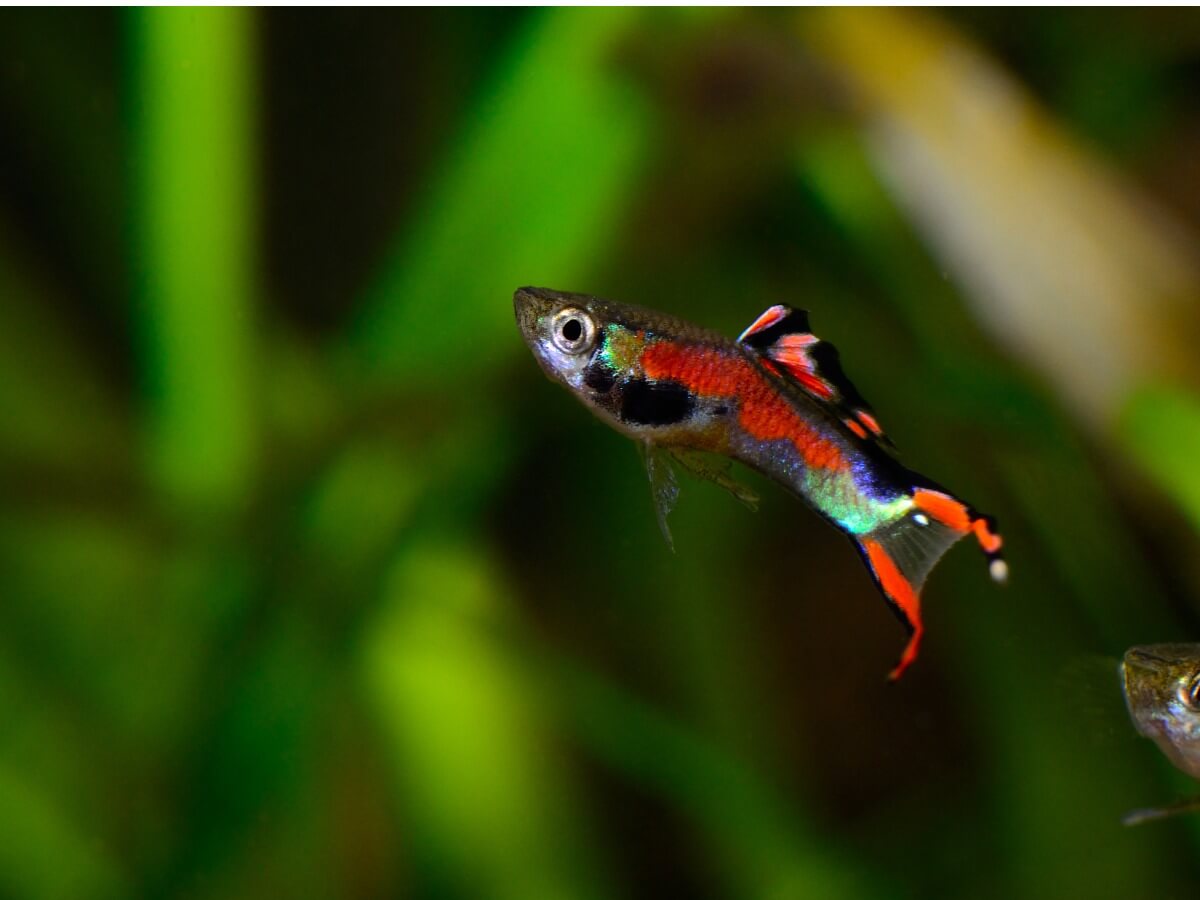
The endler is native to South America and is recognized by its curious metallic coloration with orange, silver and greenish hues. Like other guppies, this species doesn’t exceed 5 centimeters (2 inches) in length, so it’s normal to have several of them in the same aquarium.
Although they don’t require constant filtering or a continuous water flow, it’s good to regulate the conditions of the tank to take care of their health. However, it’s highly recommended that they have an environment with abundant vegetation and different obstacles.
7. Ram cichlid fish (Mikrogeophagus ramirezi)
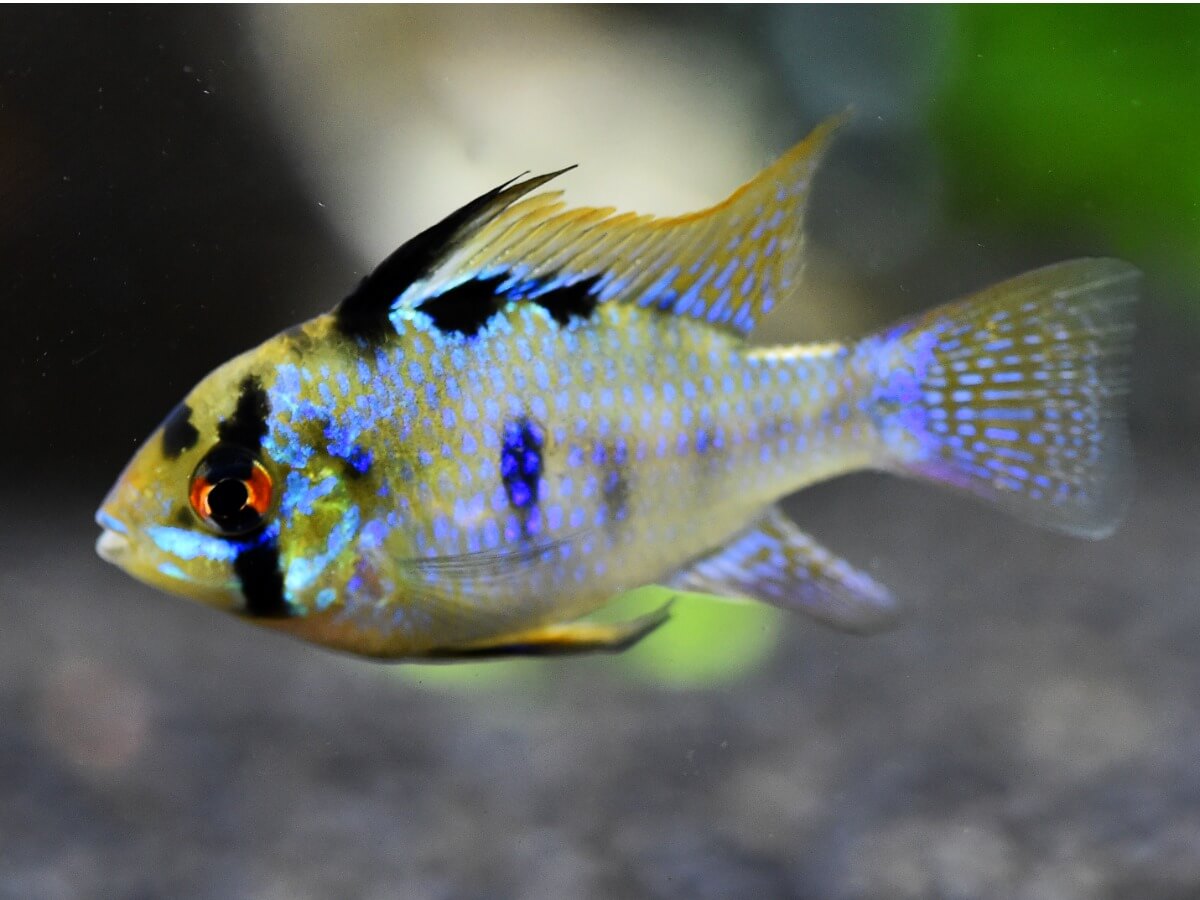
The ram cichlid fish stands out as a cichlid of compact size and vivid coloration. According to an article published in Israeli Journal of Aquaculture-Bamidgeh, the color of its body depends not only on its genetics, but also on its diet.
Therefore, it’s possible that their coloration may change progressively if consumable pigments are present in their habitat.
Contrary to other members of the list, these fish aren’t very resistant to adverse conditions and require special care. Therefore, it’s best to avoid having them in your aquarium if you aren’t yet experienced enough.
8. Boeseman’s rainbowfish (Melanotaenia boesemani)
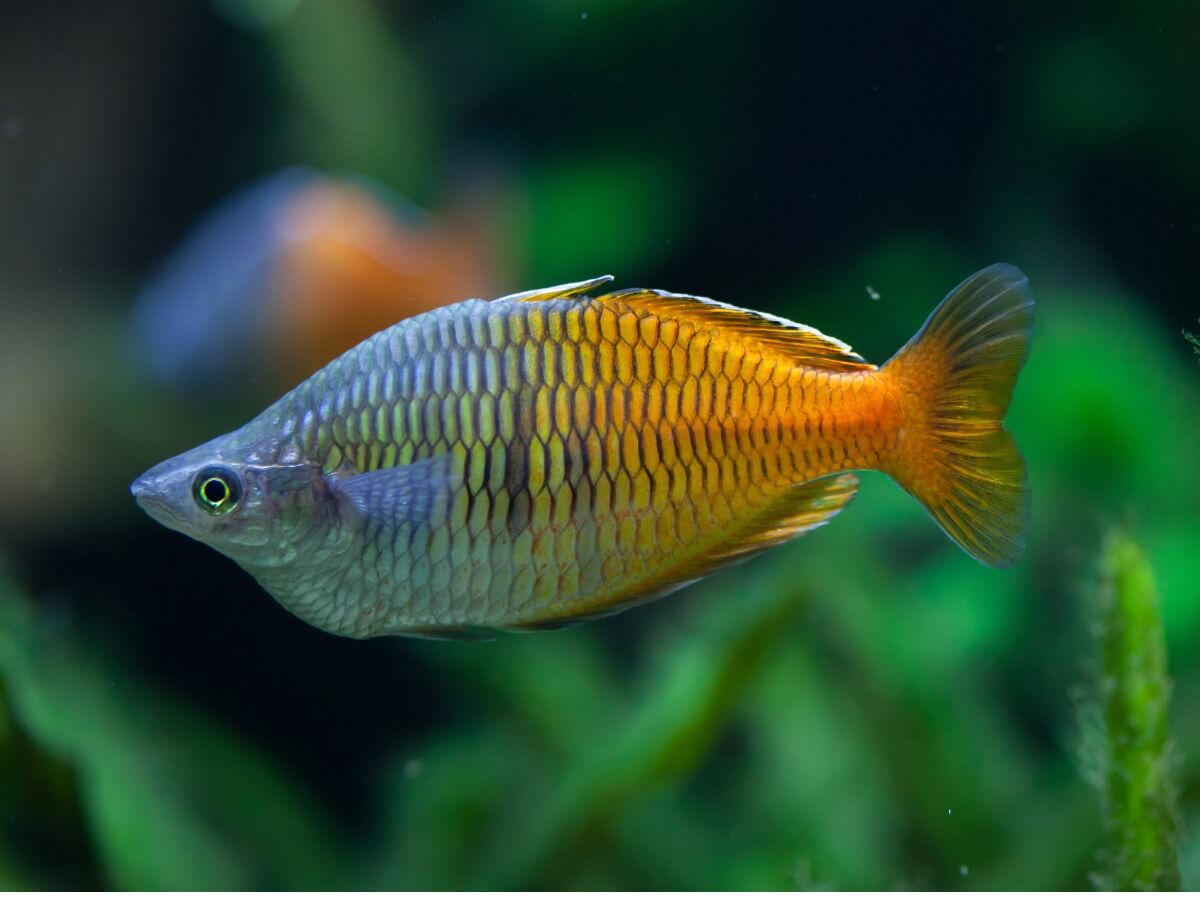
Boeseman’s rainbowfish exhibits an interesting coloration, divided into two regions: the back half with red-orange hues and the front half with gray-blue-purple. Overall, the color pattern closely resembles a rainbow. This trait explains the origin of its name.
Apart from showing interesting coloration, this species is characterized by being very tolerant of water conditions. However, it’s preferable not to exceed its limits and to offer it a suitable, vegetated environment.
9. Pearl Gourami (Trichogaster leerii)
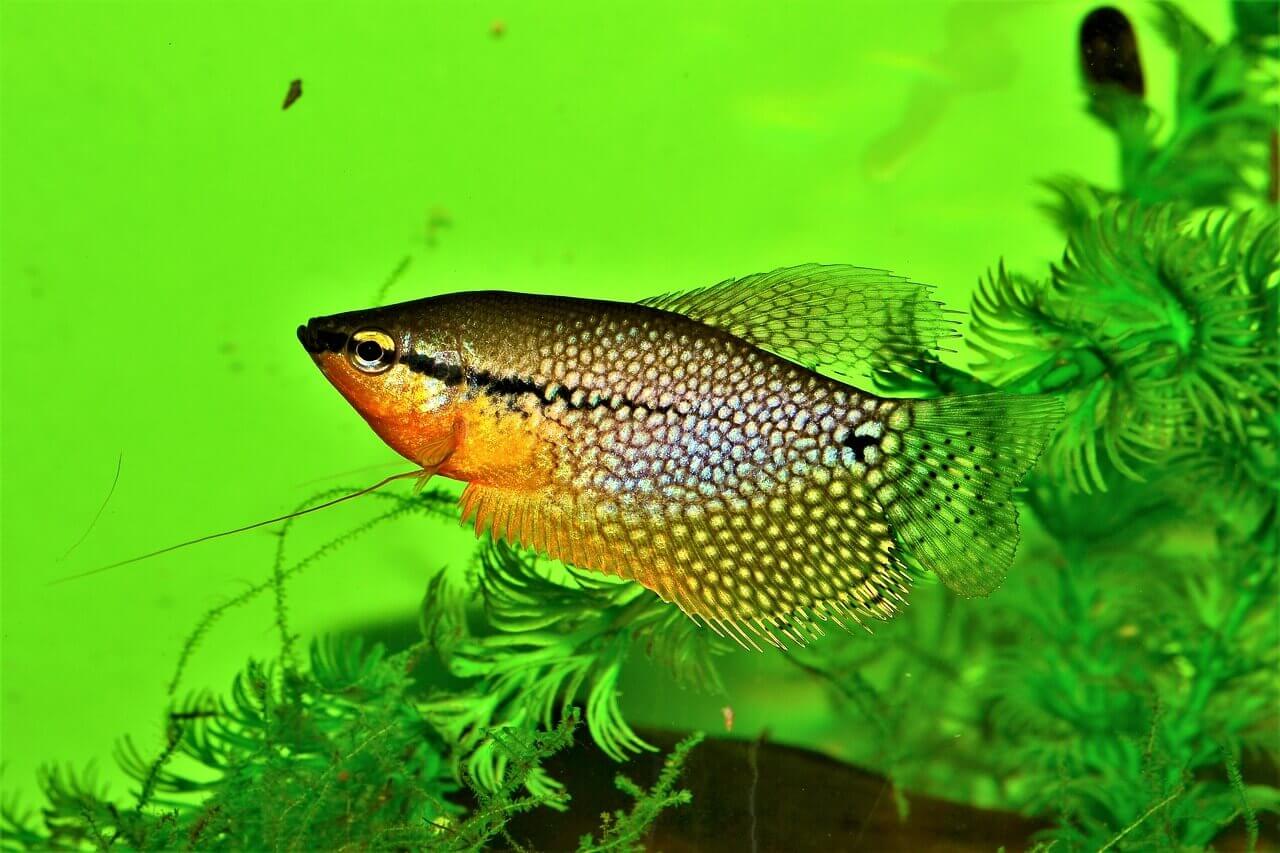
The pearl gourami is one of the most striking freshwater fish available for aquariums. It has an iridescent reddish-brown coloration, combined with silver dot patterns.
In addition, half of its body is divided by a dark line running down its side. This feature greatly highlights and accentuates the other colors of its body.
To top it off, it’s a calm species and easy to keep in the aquarium. As mentioned in an article in the Journal of Experimental Biology, it’s able to breathe air if there’s insufficient oxygen in the water, but it’s best not to stress it too much and provide it with suitable conditions.
10. Paradise fish (Macropodus opercularis)

The paradise fish is another beautiful fish species for your freshwater aquarium. They sport a bright coloration pattern composed of stripes with shades of red, green, and blue. Likewise, the fins show a color gradient that turns purple at the margins, which makes the body of the specimen stand out.
The color of the paradise fish is brighter and stronger in males than in females.
Because of this, if you’re interested in having a showy specimen, it’s better to choose a male. As for its care, this species isn’t so demanding, although it is recommended to have a complete filtering system and monitor the water quality to prevent diseases.
Variety of attractive fish for an aquarium
As you can see, there’s a great variety of attractive freshwater fish for aquariums. While it’s true that many of them don’t need too much care, it’s recommended to thoroughly review their requirements to offer them a suitable environment. Remember that fish show more intense and bright colors when they are healthy.
Aquaristics is a hobby that has gained more and more popularity. While it’s true that marine species tend to be more colorful, freshwater species are a bit easier to care for and maintain. This is one of the reasons why many enthusiasts opt to have eye-catching freshwater fish for aquariums.
If you are ready to take on the challenge and commit to their well-being, you’ll surely need ideas on some colorful species you could think about acquiring. Continue reading and discover 10 beautiful and ideal fish for your freshwater aquarium.
Striking freshwater fish for aquariums
The color of fish can be considered a simple aesthetic feature. However, for aquatic species this aspect is essential for their adaptive mechanisms. According to an article published in the journal Current Opinion in Genetics & Development
In other words, the colors of fish are a decisive factor in the evolution of species. For this reason, many of them prioritize the development of complex, colorful, and eye-catching coloration patterns.
As if that weren’t enough, selective breeding of these animals has also produced even more attractive variants. This means that brightly colored species are encouraged for decorative use in the aquarium.
Many people are attracted by the appearance of these animals, but they don’t always know their names. Therefore, we would like to share with you a list of 10 striking freshwater fish species for aquariums.
1. Betta fish (Betta splendens)

Originally from Asia, the betta fish, also known as the Siamese fighting fish, is one of the best known and most widely used species in aquarium keeping. Apart from the fact that they exhibit flashy and eye-catching colorations, their maintenance in the aquarium isn’t very complex and doesn’t require much investment.
A publication of the Electronic Veterinary Journal indicates that males tend to have the strongest coloration and the longest fins. In view of this, if you are looking for a flashy freshwater fish, it’s preferable to look for males.
That said, remember that this species tends to be aggressive towards conspecifics and other species (especially the male), so you will need to be careful when choosing mates.
2. Neon tetra fish (Paracheirodon innesi)

The neon tetra fish hails from South America and is one of the most prized freshwater fish for ornamental breeding. This is not only due to its iridescent colorations, but also to its gentle and social behavior. In addition, it is undemanding in terms of water quality and maintenance. These aspects make it an excellent addition to aquariums.
3. Goldfish (Carassius auratus)

The goldfish is perhaps the most popular freshwater fish species in the world, as its domestication is so old that it has been in the ornamental market for several hundred years. In general, it’s a small fish that boasts bright yellow and orange colors that are very attractive to the eye.
In addition, the lineage has different varieties that differ in their morphological characteristics. They range from those with larger fins, such as the kite variety, to specimens that have sacs that inflate like bubbles (bubble variety).
4. Koi fish (Cyprinus carpio koi)

Koi fish are native to the Asian continent and belong to the same species as common carp. However, this subspecies arose from selective breeding, so priority was given to maintaining intense and bright colorations in its lineage.
As a result, today’s specimens have complex color patterns that include yellow, white, orange, blue and black tones.
Like the common carp, this fish is quite resistant to adverse conditions. However, the healthiest specimens are the ones that tend to show the most showy and attractive colorations. This is one more reason to take care of your pet and not neglect its needs.
5. Angelfish (Pterophyllum scalare)

The angelfish is a species with a flattened, rhomboidal appearance that is characterized by highly elongated fins. It exhibits bright colorations with a wide range of shades, which are considered varieties. In addition, it has a medium size that shows off its coloration patterns well, although this also prevents having several specimens in a small aquarium.
Usually, the angelfish resists adverse conditions occasionally and doesn’t require much attention. Even so, it’s advisable to have a good filtration system and a wooden decoration to resemble their natural environment.
6. Endlers fish (Poecilia wingei)

The endler is native to South America and is recognized by its curious metallic coloration with orange, silver and greenish hues. Like other guppies, this species doesn’t exceed 5 centimeters (2 inches) in length, so it’s normal to have several of them in the same aquarium.
Although they don’t require constant filtering or a continuous water flow, it’s good to regulate the conditions of the tank to take care of their health. However, it’s highly recommended that they have an environment with abundant vegetation and different obstacles.
7. Ram cichlid fish (Mikrogeophagus ramirezi)

The ram cichlid fish stands out as a cichlid of compact size and vivid coloration. According to an article published in Israeli Journal of Aquaculture-Bamidgeh, the color of its body depends not only on its genetics, but also on its diet.
Therefore, it’s possible that their coloration may change progressively if consumable pigments are present in their habitat.
Contrary to other members of the list, these fish aren’t very resistant to adverse conditions and require special care. Therefore, it’s best to avoid having them in your aquarium if you aren’t yet experienced enough.
8. Boeseman’s rainbowfish (Melanotaenia boesemani)

Boeseman’s rainbowfish exhibits an interesting coloration, divided into two regions: the back half with red-orange hues and the front half with gray-blue-purple. Overall, the color pattern closely resembles a rainbow. This trait explains the origin of its name.
Apart from showing interesting coloration, this species is characterized by being very tolerant of water conditions. However, it’s preferable not to exceed its limits and to offer it a suitable, vegetated environment.
9. Pearl Gourami (Trichogaster leerii)

The pearl gourami is one of the most striking freshwater fish available for aquariums. It has an iridescent reddish-brown coloration, combined with silver dot patterns.
In addition, half of its body is divided by a dark line running down its side. This feature greatly highlights and accentuates the other colors of its body.
To top it off, it’s a calm species and easy to keep in the aquarium. As mentioned in an article in the Journal of Experimental Biology, it’s able to breathe air if there’s insufficient oxygen in the water, but it’s best not to stress it too much and provide it with suitable conditions.
10. Paradise fish (Macropodus opercularis)

The paradise fish is another beautiful fish species for your freshwater aquarium. They sport a bright coloration pattern composed of stripes with shades of red, green, and blue. Likewise, the fins show a color gradient that turns purple at the margins, which makes the body of the specimen stand out.
The color of the paradise fish is brighter and stronger in males than in females.
Because of this, if you’re interested in having a showy specimen, it’s better to choose a male. As for its care, this species isn’t so demanding, although it is recommended to have a complete filtering system and monitor the water quality to prevent diseases.
Variety of attractive fish for an aquarium
As you can see, there’s a great variety of attractive freshwater fish for aquariums. While it’s true that many of them don’t need too much care, it’s recommended to thoroughly review their requirements to offer them a suitable environment. Remember that fish show more intense and bright colors when they are healthy.
All cited sources were thoroughly reviewed by our team to ensure their quality, reliability, currency, and validity. The bibliography of this article was considered reliable and of academic or scientific accuracy.
- Akhsan, W. M., Nur, B., & Dewi, N. N. (2020). Growth performance and survival rate of Boeseman’s rainbowfish (Melanotaenia boesemani) in natural spawning technique at Depok, West Java, Indonesia. IOP Conference Series: Earth and Environmental Science, 441(1), 12-37. https://iopscience.iop.org/article/10.1088/1755-1315/441/1/012037/meta
- Burggren, W. W. (1979). Biomodal gas exchange during variation in environmental oxygen and carbon dioxide in the air breathing fish Trichogaster trichopterus. Journal of Experimental Biology, 82(1), 197-213. https://journals.biologists.com/jeb/article/82/1/197/22822/Biomodal-Gas-Exchange-During-Variation-in
- Bustamante, J. González, M. Ávalos, A. Rodríguez, M. y Cortés, A. (2019). Características biológicas del pez ángel (Pterophyllum scalare; Lichtenstein, 1823) para su producción. Universidad Autónoma Metropolitana, (1.ª ed.). https://publicaciones.xoc.uam.mx/TablaContenidoLibro.php?id_libro=824
- Chen, D., Zhang, Q., Tang, W., Huang, Z., Wang, G., Wang, Y., … & Zhang, J. (2020). The evolutionary origin and domestication history of goldfish (Carassius auratus). Proceedings of the National Academy of Sciences, 117(47), 29775-29785. https://www.pnas.org/doi/10.1073/pnas.2005545117
- Harpaz, S., & Padowicz, D. (2007). Color enhancement in the ornamental dwarf cichlid Microgeophagus ramirezi by addition of plant carotenoids to the fish diet. Israeli Journal of Aquaculture-Bamidgeh, 59(4), 195-200. https://evols.library.manoa.hawaii.edu/items/95e0ec6f-53fd-42af-b986-d84f0a66ab13
- Irion, U., & Nüsslein-Volhard, C. (2019). The identification of genes involved in the evolution of color patterns in fish. Current Opinion in Genetics & Development, 57, 31-38. https://www.researchgate.net/publication/335167173_The_identification_of_genes_involved_in_the_evolution_of_color_patterns_in_fish
- Luna-Figueroa, J., Salazar, M. S., & Torres, J. F. (2006). Crecimiento del pez Neón Paracheirodon innesi (Pisces: Characidae): Alimento vivo Moina weirzesjkii versus balanceado con diferente nivel proteico. IV Congreso Iberoamericano Virtual de Acuicultura. 875-881. https://www.researchgate.net/publication/262451465_Crecimiento_del_pez_Neon_Paracheirodon_innesi_Pisces_Characidae_Alimento_vivo_Moina_weirzesjkii_versus_balanceado_con_diferente_nivel_proteico
- Obregón, D. A. A. (2006). Crianza y producción del Betta (Betta splendens) para acuaristas no profesionales. REDVET. Revista Electrónica de Veterinaria, 7(4), 1-4. https://www.researchgate.net/publication/26432552_Crianza_y_produccion_del_Betta_Betta_splendens_para_acuaristas_no_profesionales_Raising_and_production_of_the_Betta_for_nonprofessional_acuaristas
- Poeser, F. N., Kempkes, M., & Isbrücker, I. J. (2005). Description of Poecilia (Acanthophacelus) wingei n. sp. from the Paría Peninsula, Venezuela, including notes on Acanthophacelus Eigenmann, 1907 and other subgenera of Poecilia Bloch and Schneider, 1801 (Teleostei, Cyprinodontiformes, Poeciliidae). Contributions to Zoology, 74(1-2), 97-115. https://www.researchgate.net/publication/254912176_Description_of_Poecilia_Acanthophacelus_wingei_n_sp_from_Paria_Peninsula_Venezuela_including_notes_on_Acanthophacelus_Eigenmann_1907_and_other_subgenera_of_Poecilia_Bloch_and_Schneider_1801_Teleostei_
- Price, A. C., Weadick, C. J., Shim, J., & Rodd, F. H. (2008). Pigments, patterns, and fish behavior. Zebrafish, 5(4), 297-307. https://www.researchgate.net/publication/23768570_Pigments_Patterns_and_Fish_Behavior
- Rácz, A., Adorján, G., Fodor, E., Sellyei, B., Tolba, M., Miklósi, Á., & Varga, M. (2021). Housing, Husbandry and Welfare of a “Classic” Fish Model, the Paradise Fish (Macropodus opercularis). Animals, 11(3), 786. https://www.mdpi.com/2076-2615/11/3/786
- Seehausen, Mayhew, & Alphen, J. V. (1999). Evolution of colour patterns in East African cichlid fish. Journal of Evolutionary Biology, 12(3), 514-534. https://www.researchgate.net/publication/227735607_Evolution_of_colour_patterns_in_East_African_cichlid_fish_Review
This text is provided for informational purposes only and does not replace consultation with a professional. If in doubt, consult your specialist.








